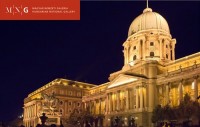Strange figures populate the paintings of István Farkas in the 1930s. The enigmatic, often downcast paintings of István Farkas feature an array of strange characters. The madman of Syracuse stands in a remote, desolate landscape, watched over by a smouldering Mount Etna. The image comprises only a few motifs: the roadway, a boxlike house, and a dog. The largest part of the picture is covered in an expanse of ochre ground, invaded by the black patch of the sea. The use of tempera means that spatial relations are uncertain, so depth is conveyed by the winding road. Coming towards us along the road is the madman, coloured in an echo of his surroundings: the greenish yellow of his clothes blends in with the landscape, his beard is the same shade of ochre as the soil, while his shirt and shoes match the white of the road. His left arm is raised in an undecipherable gesture, and there is no way of knowing the purpose of the barbed stick in his right hand; this puzzling figure is the ominous harbinger of unknowable events.
en

